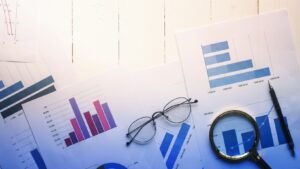In today’s digital age, data is the new gold. But it’s not enough to just hoard this gold; it’s crucial to understand and interpret it. That’s where data analysis and visualization come into play. They’re powerful tools that help businesses make informed decisions, identify trends, and predict future outcomes.
Data analysis is the process of inspecting, cleaning, and modeling data to discover useful information. Visualization, on the other hand, is the art of presenting data in a graphical format that makes complex data more understandable and usable. Together, they’re transforming the way businesses operate, offering insights that were previously hidden in raw data.
In this article, we’ll explore the importance of data analysis and visualization, and how they’re shaping the future of business. So, whether you’re a data enthusiast or a business professional looking to leverage data, there’s something in it for you. Let’s dive into the fascinating world of data analysis and visualization.
Data Analysis and Visualization
 Given the crucial role data plays in contemporary society, its proper scrutiny ought to be a high priority. Grasping and leveraging data calls for an analytically rigorous approach. Unlike raw data, quality data analysis provides actionable insights, contributing to more informed decision-making. This section underscores the importance of data analysis and visualization. It dives into why data analysis holds significance and how visualization aids in data comprehension.
Given the crucial role data plays in contemporary society, its proper scrutiny ought to be a high priority. Grasping and leveraging data calls for an analytically rigorous approach. Unlike raw data, quality data analysis provides actionable insights, contributing to more informed decision-making. This section underscores the importance of data analysis and visualization. It dives into why data analysis holds significance and how visualization aids in data comprehension.
The weight of data analysis in today’s world can’t be overstated. It isn’t simply a buzzword tossed around boardrooms and strategy meetings—it’s a must-have tool for modern businesses. Data, when proficiently analyzed, surface invaluable insights that can bolster business strategies, streamline operations, and boost overall performance. Moreover, data analysis aids in trend identification, highlighting market tendencies before they become apparent to others.
Key Techniques in Data Analysis
 Data analysis involves a variety of techniques and methods, with two of the most prevalent being descriptive and predictive analysis. These provide a comprehensive picture of the data at hand, allowing experts to glean valuable insights.
Data analysis involves a variety of techniques and methods, with two of the most prevalent being descriptive and predictive analysis. These provide a comprehensive picture of the data at hand, allowing experts to glean valuable insights.
Descriptive analysis techniques constitute the cornerstone of data analysis. They extract significant features from raw data, identifying patterns and relationships. The primary tools for these techniques include measures of central tendency (mean, median, mode), measures of dispersion (standard deviation, variance), and frequency distribution.
Predictive Analysis Tools
Predictive analysis tools uniquely answer the question ‘What’s likely to happen in the future?’ based on historical data. They use statistical algorithms and machine-learning techniques to analyze current and historical facts to make predictions about future events.
Essential Tools for Data Visualization
 Data visualization, as a core aspect of data analytics, leverages sophisticated, user-friendly software for portraying data in a visually intuitive manner. This section delves into the critical factors involved while selecting a visualization software, as well as popular tools used by industry professionals.
Data visualization, as a core aspect of data analytics, leverages sophisticated, user-friendly software for portraying data in a visually intuitive manner. This section delves into the critical factors involved while selecting a visualization software, as well as popular tools used by industry professionals.
In selecting visualization software, attention to a handful of critical elements often matters. Ease of use comes first as the tool must have a friendly interface with intuitiveness in navigation. Also, software providing a wide range of visualization options can accommodate varying data styles. Integratability is another significant aspect to consider, with the software offering seamless integration with most-used data analysis platforms. Pricing is also an area to explore, as some of these tools offer free versions, while others charge a fee.
- Tableau: This platform offers drag-and-drop capability, facilitating the creation of interactive dashboards quickly. It provides real-time data analytics and cloud support.
- PowerBI: Microsoft’s PowerBI is notable for its seamless integration with other Microsoft products. It encompasses significant data connectivity and data preparation options.
- QlikView: QlikView provides unique features such as associative data indexing and guided analytics. It’s a reliable option for dealing with large data sets, offering top-notch scalability features.
The choice in data visualization tools often relies on specific needs and contexts. Each tool mentioned has distinct features catering to various data visualization demands of users, thereby adding to the effectiveness of data analysis. With appropriate tools in hand, the power of data can be harnessed effectively for insightful decision-making.

